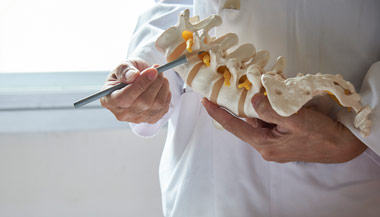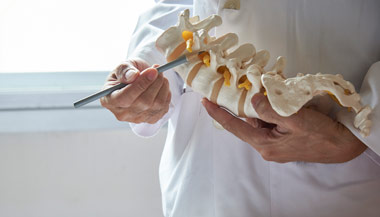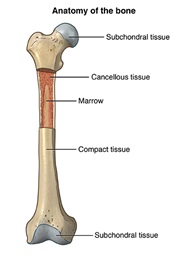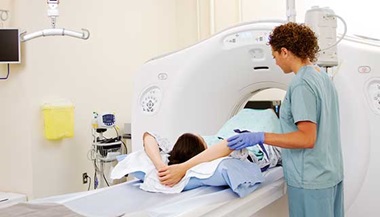Bone Scan
What is a bone scan?
(Bone Scintigraphy)
A bone scan is a specialized radiology procedure used to examine the various bones of the skeleton. It is done to identify areas of physical and chemical changes in bone. A bone scan may also be used to follow the progress of treatment of certain conditions.
A bone scan is a type of nuclear radiology procedure. This means that a tiny amount of a radioactive substance is used during the procedure to assist in the examination of the bones. The radioactive substance, called a radionuclide, or tracer, will collect within the bone tissue at spots of abnormal physical and chemical change.
The radionuclide emits a type of radiation, called gamma radiation. The gamma radiation is detected by a scanner, which processes the information into a picture of the bones.
The areas where the radionuclide collects are called "hot spots," and may indicate the presence of conditions such as arthritis , malignant (cancerous) bone tumors , metastatic bone cancer (cancer which has spread from another site, such as the lungs), bone infections , bone trauma not seen on ordinary X-rays, and other conditions of the bone.
Why might I need a bone scan?
Bone scans are used primarily to detect the spread of metastatic cancer. Because cancer cells multiply rapidly, they will appear as a hot spot on a bone scan. This is due to the increased bone metabolism and bone repair in the area of the cancer cells. Bone scans may also be used to stage the cancer before and after treatment in order to assess the effectiveness of the treatment.
Other reasons for performing a bone scan procedure may include, but are not limited to, the following:
-
To assess for bone trauma in situations where ordinary X-rays do not reveal trauma
-
To detect fractures that are difficult to locate
-
To determine the age of fractures
-
To detect and/or assess bone infections ( osteomyelitis )
-
To assess unexplained bone pain
-
To detect conditions such as arthritis , benign bone tumors, Paget's disease (a bone disorder, usually occurring in people over age 50, in which there is thickening and softening of the bones, and curving of the long bones), and avascular necrosis (death of bone tissue due to loss of blood supply to the bones)
There may be other reasons for your doctor to recommend a bone scan.
What are the risks of a bone scan?
The amount of the radionuclide injected into your vein for the procedure is small enough that there is no need for precautions against radioactive exposure. The injection of the tracer may cause some slight discomfort. Allergic reactions to the tracer are rare, but may occur.
Patients who are allergic to or sensitive to medications, contrast dyes, or latex should notify their doctor.
If you are pregnant or suspect that you may be pregnant, you should notify your health care provider due to the risk of injury to the fetus from a bone scan. If you are lactating, or breastfeeding, you should notify your health care provider due to the risk of contaminating breast milk with the tracer.
There may be other risks depending on your specific medical condition. Be sure to discuss any concerns with your doctor prior to the procedure.
How do I prepare for a bone scan?
PRECAUTIONS: If you are pregnant or think you may be pregnant, please check with your doctor before scheduling the exam. We will discuss other options with you and your doctor.
BREASTFEEDING: If you are breastfeeding, you should notify your health care provider due to the risk of contaminating breast milk with the tracer.
CLOTHING: You may be asked to change into a patient gown. A gown will be provided for you. Lockers are provided to secure your personal belongings. Please remove all piercings and leave all jewelry and valuables at home.
EAT/DRINK: Generally, no prior preparation, such as fasting or sedation, is required prior to a bone scan.
ALLERGIES: Notify the radiologist or technologist if you are allergic to or sensitive to medications, contrast dyes or iodine. The injection of the radiotracer may cause some slight discomfort. Allergic reactions to the radiotracer are rare, but may occur.
-
You may be asked to sign a consent form that gives your permission to do the test. Read the form carefully and ask questions if something is not clear.
-
Generally, no prior preparation, such as fasting or sedation, is required prior to a bone scan.
-
Notify the radiologist or technologist if you are allergic to or sensitive to medications, contrast dyes, or iodine.
-
If you are pregnant or suspect you may be pregnant, you should notify your health care provider.
-
Based on your medical condition, your doctor may request other specific preparation.
.png?h=255&iar=0&mh=360&mw=520&w=200&hash=BDB6F83DF442DEFCE05293AF8EEAFDD3)
What happens during a bone scan?
A bone scan may be performed on an outpatient basis or as part of your stay in a hospital. Procedures may vary depending on your condition and your doctor's practices.
Generally, a bone scan follows this process:
-
You may be asked to remove any clothing, jewelry, or other objects that may interfere with the procedure.
-
If you are asked to remove clothing, you will be given a gown to wear.
-
An intravenous (IV) line will be started in the hand or arm for injection of the tracer.
-
The tracer will be injected into your vein. The tracer will be allowed to concentrate in the bone tissue for a period of one to three hours. You may be allowed to walk around or even leave the facility during this time. You will not be hazardous to other people, as the tracer emits less radiation than a standard X-ray.
-
During the waiting period, you will need to drink several glasses of water (four to six glasses) to help flush out any tracer that does not concentrate into the bone tissue.
-
If your bone scan is being done to detect bone infection, a set of scans may be done immediately after the injection of the tracer. Another set of scans will be done after the tracer has been allowed to concentrate in the bone tissue.
-
When the tracer has been allowed to concentrate in the bone tissue for the appropriate amount of time, you will be asked to empty your bladder prior to the start of the scan. A full bladder can distort the bones of the pelvis, and may become uncomfortable during the scan, which may take up to an hour to complete.
-
You will be asked to lie still on a scanning table, as any movement may affect the quality of the scan.
-
The scanner will move slowly over you several times as it detects the gamma rays emitted by the tracer in the bone tissue.
-
You may be repositioned during the scan in order to obtain particular views of the bones.
-
When the scan has been completed, the IV line will be removed.
While the bone scan itself causes no pain, having to lie still for the length of the procedure might cause some discomfort or pain, particularly in the case of a recent injury or invasive procedure such as surgery. The technologist will use all possible comfort measures and complete the procedure as quickly as possible to minimize any discomfort or pain.
What happens after the bone scan?
You should move slowly when getting up from the scanner table to avoid any dizziness or lightheadedness from lying flat for the length of the procedure.
You will be instructed to drink plenty of fluids and empty your bladder frequently for 24 to 48 hours after the procedure to help flush the remaining tracer from your body.
The IV site will be checked for any signs of redness or swelling. If you notice any pain, redness, and/or swelling at the IV site after you return home following your procedure, you should notify your doctor as this may indicate an infection or other type of reaction.
You should not have any other radionuclide procedures for the next 24 to 48 hours after your bone scan.
You may resume your usual diet and activities, unless your doctor advises you differently.
Your doctor may give you additional or alternate instructions after the procedure, depending on your particular situation.





